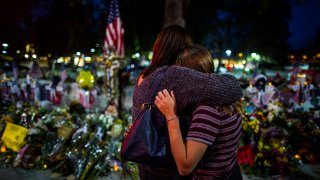
An overwhelmed 911 system, chaos and delays hampered the law enforcement response to a Southern California bar during a 2018 attack that killed a dozen people, a report released Wednesday concluded.
The after-action report cited a series of problems that created confusion after a Marine veteran opened fire with a handgun inside the Borderline Bar & Grill on Nov. 7, 2018, in Thousand Oaks, about a half-hour's drive north of Los Angeles.
Ian David Long, 28, used a flashlight with a laser sight attached to a .45-caliber semiautomatic pistol. He fired 61 shots at staff and customers — many of them college students — in the crowded bar and dance hall. He had more than 150 bullets left when he stopped to attack arriving law enforcement, and then he killed himself, authorities said.
Because of communications problems, it took nearly a half-hour for sheriff's deputies to rescue a colleague who was shot as he entered the building, and then for a SWAT team to make a second entrance to the building where they found Long dead, the report said.
Get top local stories in Southern California delivered to you every morning. >Sign up for NBC LA's News Headlines newsletter.
The 88-page report gives a blow-by-blow account of the shooting and its aftermath and makes 30 recommendations for upgrading communications, training and responses, some of which already have been adopted.
Long entered the bar and dance hall shortly before 11:30 p.m. and opened fire, mowing down people near the entrance, the report said. He moved through the building, throwing smoke grenades as people scrambled to flee, some using chairs and tables to break windows and jump out.
Long also shot injured or hiding patrons, the report said.
Local
Get Los Angeles's latest local news on crime, entertainment, weather, schools, COVID, cost of living and more. Here's your go-to source for today's LA news.
In the first 15 minutes after the first shots were fired, sheriff’s 911 dispatchers received nearly 90 calls from deputies in the field, other staff members and the media, and the noise level in the dispatch center was so high that it became difficult for the watch commander there to hear what was going on, the report said.
“It was equally difficult to obtain accurate and complete information from injured and panicked callers, who were yelling and screaming into their phones,” according to the report.
The surge in calls caused a delay in authorizing deputies from other stations, including SWAT members, to be sent to the bar, the report said.
A supervisor emailed off-duty dispatchers to come in but because of the hour many already had gone to sleep, according to the report.
The report also noted that sheriff’s Sgt. Ron Helus and a California Highway Patrol officer who arrived just minutes after the shooting began were ambushed as they entered the bar because Long had seen them on the bar’s surveillance cameras.
Helus, 54, was shot five times but he died from a shot fired in return by the CHP officer, who dragged him outside to cover, the report said.
The CHP officer radioed “Officer down! Officer down!” to CHP dispatch but other sheriff's deputies at the scene didn't hear that first call because the two departments were using different radio frequencies, the report said.
The report said at least five deputies were at the scene and near the bar at the time Helus was shot and heard the 22-second gun battle but none moved into a supporting position and there was “no coordinated communication or response developed," the report said, stating: “little beyond containment was provided."
Three armed off-duty law enforcement officers, including a sheriff’s deputy who had graduated from the training academy less than a month earlier, were in the bar and they were preparing to move toward the gunman but by then uniformed deputies had arrived and they feared being mistaken for attackers, the report said.
A SWAT captain finally arrived and organized a second entry into the building about a half-hour after Helus was shot, the report said. At that point, there were about a dozen deputies, along with Helus and two CHP officers.
Long, however, was seen on video killing himself about 16 minutes after entering the bar.
The report stated that “waiting for SWAT is rarely the preferred option” but said deputies — who didn't know the shooter was dead — had to consider the danger of going inside with the need to perhaps rescue trapped people.
In the end, they did find and bring out 19 people who had been hiding.
The report states that, unknown to the deputies at the time, “all of the injured victims inside the building had suffered mortal injuries and could not have been saved."
Friends and family said Long, who had served in the Afghanistan war, may have suffered from post-traumatic stress disorder, the report said.
They also said he expressed hate towards civilians, especially college students, and felt they were disrespectful to the military.
During the shooting, Long posted two Facebook messages. In one, he said “Fact is, I had no reason to do it and just thought…life is boring, so why not?”
Long also had visited websites “that demonstrate a propensity for mass violence, suicide, and murder,” the report said.
However, the report said that Long didn't leave a note or manifesto and “we will likely never know the true motivation behind the attack."



